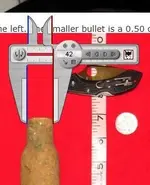GpSnoopy, no offense intended, but despite my saying "Adios" to the Original Poster, I must add a caution-note about that method of size estimation. I've tried to do the same thing you did. But there can be a problem with it... which might be called "lens-distance perspective." Actual size is difficult to accurately estimate when two objects are at different distances from the camera's lens. In this case, the tape-measure (which is laying flat on the table) is an inch or so further away from the camera's lens than the casing's mouth (which is "in the air" above the table's surface. If you raised the tape-measure up off the table to the casing's mouth, the tape-measure would become a bit "larger" in the photo.
A clearer example:
That "perspective" problem is more obvious when somebody posts a photo made with a camera looking straight-down on a metal ball with a tape-measure laying flat on the table beside the ball. Even though I know for certain that the ball's diameter is 2.9-inches, the tape-measure laying flat on the table "below" the ball makes the ball appear to be 3.5-inches wide.
Please don't misinterpret those statements as me complaining about your post. I appreciate the effort you obviously put into it. You've proved that the casing is not a 30mm or 37mm casing. Unfortunately, the only way to know the true size is for the Original Poster to stretch a tape-measure directly across the center of the casing's mouth. But at present, it seems he has no interest in doing that for us relic-ID helpers.












